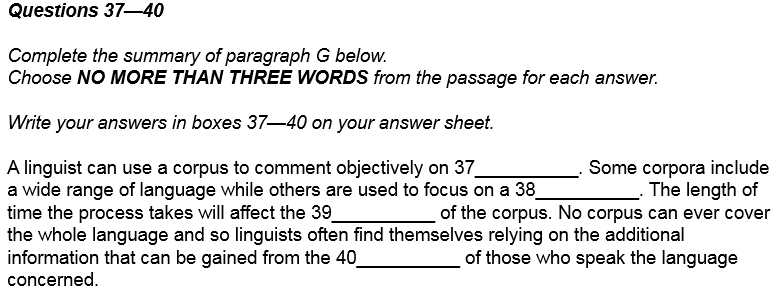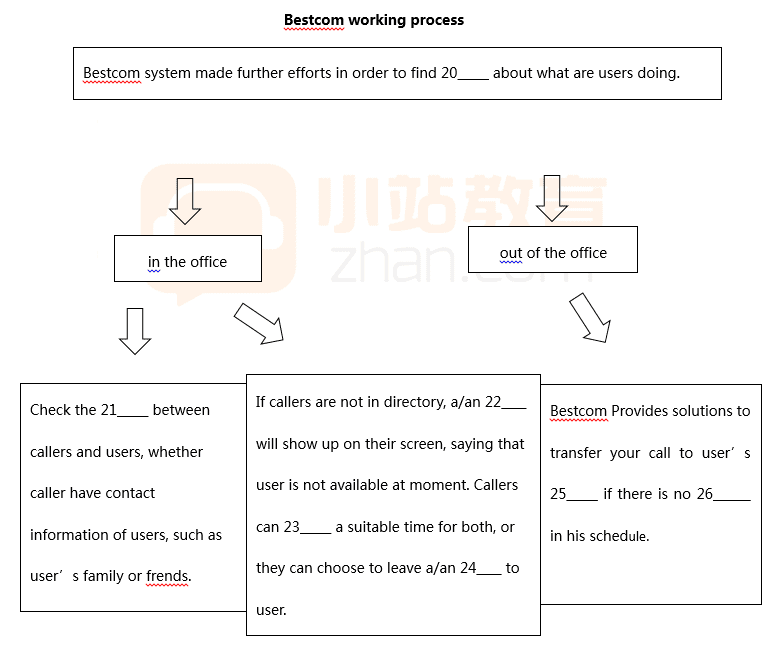托福阅读考试注意的哪些内容?今天小编给大家带来了托福阅读考试注意的三点内容,希望能够帮助到大家,下面小编就和大家分享,来欣赏一下吧。
托福阅读考试注意的三点内容
第一点,词汇量是关键。
我2001年4月去新东方上TOEFL班,当时就是词汇量很贫乏(那年夏天考6级都没过)后来因为还有其它的事情,复习的时间只有20天,单词当然没有增加多少。当时做阅读就觉得简直太可怕了,基本上云山雾罩的。还专门又好好看了一遍做题技巧,还是不爽。成绩,54吧。后来考了GRE,再加上GRE阅读的地狱般的磨炼,再来看TOEFL阅读,我发现,我全部都看懂了!然后做题觉得挺好的。因此,各位如果觉得TOEFL阅读很难的话,请你一定要肯拿出时间来背单词。磨刀不误砍柴工,这句话一点都不假。即使你用一周时间,能把80%的单词都记住,那也是很值得的。
第二,阅读的做题顺序。
现在还有人问,新东方说先看问题再读文章,又说自己不习惯等等。其实,这个完全在你自己。如果你觉得“先看问题再读文章,而且找到答案就停止,再读下一个问题”这样很习惯,那就保持下去。如果你觉得整个文章读完再做心里踏实,那就读完好了。我后来做阅读,是这样的。第一题,一般都是主题题。先不管。从第二题开始,看问题,然后看是读第一段。不管有没有找到答案,把这一段读完再停。这样,如果词基本认识,句子结构比较清楚的话,答案差不多就出来了。接下来还是这样,即使那一段很长,我也是读完一整段再做题。!但是这里要强调一下。如果你的阅读水平不是特别高的话,当你读完一段,有些问题的答案你可能已经知道了,但是还是请定位到原文,再看一遍。看看问题问的是不是的确就是你得出的答案等等。总之一句话,阅读的答案都是从文章里来的,如果和文章矛盾了或者文章没有这些说法,那就肯定不是正确答案!
第三,解题技巧。
什么?就是排除法!遇到不确定的题目,一定从原文找到定位,然后把肯定不对的选项排除。就算是瞎蒙,50%也比25%好。这个也是做主题题的一贯原则。等你把文章通篇都读完了,再回过头看这个题目的时候,不正确的说法就可以排除了(如果你也是最后做主题题的话,一定不要忘了,还有一道题!
再补充几句,我推荐阅读也进行限时连续练习。就是每套题不超过53分钟,连续做两套。这可是最后的部分了,最容易疲劳的阶段,因此也需要适应性训练。同样在答题纸上写答案。至于总结,不多,1,错题看看是为什么错的,是不是因为定位没找对,或者别的什么原因。2,就是把做过的阅读里出现的词对,就是那些单词题的正确选项都摘抄下来,尽管重复的几率不大,但是有些词是经常出现的,而且你可以熟悉一下这些词都是什么意思
托福阅读真题原题+题目
Potash (the old name for potassium carbonate) is one of the two alkalis (the other being soda,sodium carbonate) that were used from remote antiquity in the making of glass, and from theearly Middle Ages in the making of soap: the former being the product of heating a mixture ofalkali and sand, the latter a product of alkali and vegetable oil. Their importance in thecommunities of colonial North America need hardly be stressed.
Potash and soda are not interchangeable for all purposes, but for glass- or soap-making eitherwould do. Soda was obtained largely from the ashes of certain Mediterranean sea plants, potashfrom those of inland vegetation. Hence potash was more familiar to the early European settlersof the North American continent.
The settlement at Jamestown in Virginia was in many ways a microcosm of the economy ofcolonial North America, and potash was one of its first concerns. It was required for theglassworks, the first factory in the British colonies, and was produced in sufficient quantity topermit the inclusion of potash in the first cargo shipped out of Jamestown. The second ship toarrive in the settlement from England included among its passengers experts in potash making.
The method of making potash was simple enough. Logs was piled up and burned in the open,and the ashes collected. The ashes were placed in a barrel with holes in the bottom, and waterwas poured over them. The solution draining from the barrel was boiled down in iron kettles. Theresulting mass was further heated to fuse the mass into what was called potash.
In North America, potash making quickly became an adjunct to the clearing of land foragriculture, for it was estimated that as much as half the cost of clearing land could be recoveredby the sale of potash. Some potash was exported from Maine and New Hampshire in theseventeenth century, but the market turned out to be mainly domestic, consisting mostly ofshipments from the northern to the southern colonies. For despite the beginning of the trade atJamestown and such encouragements as a series of acts to encourage the making of potash,beginning in 1707 in South Carolina, the softwoods in the South proved to be poor sources of thesubstance.
1. What aspect of potash does the passage mainly discuss?
(A) How it was made
(B) Its value as a product for export
(C) How it differs from other alkalis
(D) Its importance in colonial North America
2. All of the following statements are true of both potash and soda EXPECT:
(A) They are alkalis.
(B) They are made from sea plants.
(C) They are used in making soap.
(D) They are used in making glass.
3. They phrase the latter in line 4 refers to
(A) alkali
(B) glass
(C) sand
(D) soap
4. The word stressed in line 6 is closest in meaning to
(A) defined
(B) emphasized
(C) adjusted
(D) mentioned
5. The word interchangeable in line 7 is closest in meaning to
(A) convenient
(B) identifiable
(C) equivalent
(D) advantageous
6. It can be inferred from the passage that potash was more common than soda in colonial North
America because
(A) the materials needed for making soda were not readily available
(B) making potash required less time than making soda
(C) potash was better than soda for making glass and soap
(D) the colonial glassworks found soda more difficult to use
7. According to paragraph 4, all of the following were needed for making potash EXCEPT
(A) wood
(B) fire
(C) sand
(D) water
8. The word adjunct in line 22 is closest in meaning to
(A) addition
(B) answer
(C) problem
(D) possibility
9. According to the passage , a major benefit of making potash was that
(A) it could be exported to Europe in exchange for other goods
(B) it helped finance the creation of farms
(C) it could be made with a variety of materials
(D) stimulated the development of new ways of glassmaking
10. According to paragraph 5, the softwoods in the South posed which of the following problems
for southern settles?
(A) The softwoods were not very plentiful.
(B) The softwoods could not be used to build houses.
(C) The softwoods were not very marketable.
(D) The softwoods were not very useful for making potash.
PASSAGE 6 DBDBC ACABD
托福阅读真题原题+题目
Perhaps the most obvious way artistic creation reflects how people live is by mirroring theenvironment — the materials and technologies available to a culture. Stone, wood, tree bark, clay,and sand are generally available materials. In addition, depending on the locality, other resourcesmay be accessible: shells, horns, gold, copper, and silver. The different uses to which societies putthese materials are of interest to anthropologists who may ask, for example, why people chooseto use clay and not copper when both items are available. Although there are no conclusiveanswers yet, the way in which a society views its environment is sometimes apparent in its choiceand use of artistic materials. The use of certain metals, for example, may be reserved forceremonial objects of special importance. Or the belief in the supernatural powers of a stone ortree may cause a sculptor to be sensitive to that material.
What is particularly meaningful to anthropologist is the realization that although thematerials available to a society may to some extent limit or influence what it can do artistically,the materials by no means determine what is done. Why do the artists in Japanese society rakesand into patterns; and the artists in Roman society melt sand to form glass? Moreover, evenwhen the same material is used in the same way by members of different societies, the form orstyle of the work varies enormously from culture to culture. A society may simply choose torepresent objects or phenomena that are important to its population. An examination of the artof the Middle Ages tells us something about the medieval preoccupation with theologicaldoctrine. In addition to revealing the primary concerns of a society, the content of that society'sart may also reflect the culture's social stratification.
1. According to the passage , gold, copper, and silver are
(A) more difficult to handle than wood and
(B) of their stable social conditions
(C) of the unique stylistic features of their art
(D) available only in specific locations
2. The word conclusive in line 7 is closest in meaning to
(A) definitive
(B) controversial
(C) concurrent
(D) realistic
3. The word apparent in line 8 is closest in meaning to
(A) attractive
(B) logical
(C) evident
(D) distinct
4. Why does the author mention the supernatural powers of a stone or tree in line 10?
(A) to show that some sculptors avoid working with specific materials
(B) to emphasize the unusual properties of certain materials
(C) as an example of how art can be influenced by cultural beliefs
(D) as an illustration of the impact of the environment on religious beliefs
5. The word it in line 13 refers to
(A) realization
(B) society
(C) extent
(D) influence
6. It can be inferred that the author mentions the Japanese and Roman societies because
(A) they influenced each other stone
(B) commonly used by artists in all societies
(C) essential to create ceremonial objects
(D) they used the same artistic material in very different ways
7. According to the passage , all of the following statements about sand are true EXCEPT
(A) It is used to create glass.
(B) Roman artists mix it into their paints.
(C) Its use varies from culture to culture.
(D) Japanese artists use it to create artistic patterns.
8. The word Moreover in line 16 is closest in meaning to
(A) similarly
(B) in addition
(C) in contrast
(D) frequently
9. The word preoccupation in line 20 is closest in meaning to
(A) involvement
(B) separation
(C) relationship
(D) argument
10. The word primary in line 21 is closest in meaning to
(A) discrete
(B) preliminary
(C) ideal
(D) fundamental
PASSAGE 5 DACCB DBBAD
托福阅读考试注意的三点内容相关文章:
★ 3个月备考托福攻略
★ 雅思和托福的区别
托福阅读考试注意的三点内容
上一篇:托福阅读得到高分三原则
下一篇:托福阅读满分需要经历哪些训练





